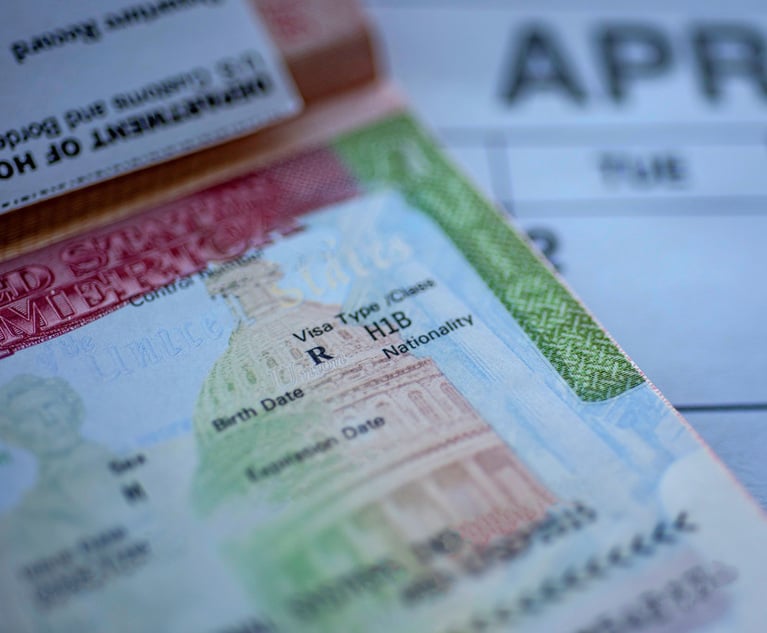Asylum: The Sufficiency of Death Threats in Proving Past Persecution
"Going forward, it will behoove asylum applicants and their counsel to present evidence of these aggravating circumstances when seeking asylum," write Paul Weiss' Martin Flumenbaum and Brad S. Karp.
July 29, 2024 at 02:00 PM
8 minute read
 Martin Flumenbaum, left, and Brad S. Karp
Martin Flumenbaum, left, and Brad S. Karp In KC v. Garland, ____ F.4th ____ (2d Cir. 2024), the U.S. Court of Appeals for the Second Circuit addressed whether death threats are sufficient to establish that an asylum applicant has faced past persecution. In a unanimous opinion authored by Circuit Judge Richard Sullivan and joined by Chief Judge Debra Ann Livingston and Senior Circuit Judge José Cabranes, the Second Circuit rejected a per se rule that an asylum applicant who has received death threats has demonstrated past persecution. Instead, in line with prior Second Circuit precedent, death threats "will constitute past persecution only if the applicant can point to aggravating circumstances indicating that the death threat was 'so imminent or concrete' or 'so menacing as itself to cause actual suffering or harm.'" 2024 WL 3433555 at *4 (quoting Scarlett v. Barr, 957 F.3d 316, 328 (2d Cir. 2020)). Going forward, it will behoove asylum applicants and their counsel to present evidence of these aggravating circumstances when seeking asylum.
Second Circuit Approach to Past Persecution in Asylum Claims
In the Second Circuit, an asylum applicant bears the burden of proving eligibility for asylum. Id. at *3. One way to meet that burden is to demonstrate a well-founded fear of future persecution on account of race, religion, nationality, membership in a particular social group, or political opinion. Id. An applicant that can demonstrate past persecution is "presumed to have a well-founded fear of [future] persecution." Id. (quoting Singh v. Garland, 11 F.4th 106, 114 (2d Cir. 2021). The government may rebut that presumption by showing that there has been a "fundamental change in circumstances" or that the applicant can avoid future persecution by relocating to a different part of the country. Id. (quoting Singh, 11 F.4th at 114).
This content has been archived. It is available through our partners, LexisNexis® and Bloomberg Law.
To view this content, please continue to their sites.
Not a Lexis Subscriber?
Subscribe Now
Not a Bloomberg Law Subscriber?
Subscribe Now
NOT FOR REPRINT
© 2025 ALM Global, LLC, All Rights Reserved. Request academic re-use from www.copyright.com. All other uses, submit a request to [email protected]. For more information visit Asset & Logo Licensing.
You Might Like
View All
Law Firms Expand Scope of Immigration Expertise Amid Blitz of Trump Orders
6 minute read
Workers' Attempt to Link H-1B Hiring to Tax Fraud Falls Short With 2nd Circuit
3 minute read
'Where Were the Lawyers?' Judge Blocks Trump's Birthright Citizenship Order
3 minute read
Hours After Trump Takes Office, Democratic AGs Target Birthright Citizenship Order
4 minute readTrending Stories
- 1With DEI Top of Mind, Black Judges Discuss Growing Up During Segregation, Efforts to Diversify the Profession
- 2Big Law's Middle East Bet: Will It Pay Off?
- 3'Translate Across Disciplines': Paul Hastings’ New Tech Transactions Leader
- 4Milbank’s Revenue and Profits Surge Following Demand Increases Across the Board
- 5Fourth Quarter Growth in Demand and Worked Rates Coincided with Countercyclical Dip, New Report Indicates
Who Got The Work
J. Brugh Lower of Gibbons has entered an appearance for industrial equipment supplier Devco Corporation in a pending trademark infringement lawsuit. The suit, accusing the defendant of selling knock-off Graco products, was filed Dec. 18 in New Jersey District Court by Rivkin Radler on behalf of Graco Inc. and Graco Minnesota. The case, assigned to U.S. District Judge Zahid N. Quraishi, is 3:24-cv-11294, Graco Inc. et al v. Devco Corporation.
Who Got The Work
Rebecca Maller-Stein and Kent A. Yalowitz of Arnold & Porter Kaye Scholer have entered their appearances for Hanaco Venture Capital and its executives, Lior Prosor and David Frankel, in a pending securities lawsuit. The action, filed on Dec. 24 in New York Southern District Court by Zell, Aron & Co. on behalf of Goldeneye Advisors, accuses the defendants of negligently and fraudulently managing the plaintiff's $1 million investment. The case, assigned to U.S. District Judge Vernon S. Broderick, is 1:24-cv-09918, Goldeneye Advisors, LLC v. Hanaco Venture Capital, Ltd. et al.
Who Got The Work
Attorneys from A&O Shearman has stepped in as defense counsel for Toronto-Dominion Bank and other defendants in a pending securities class action. The suit, filed Dec. 11 in New York Southern District Court by Bleichmar Fonti & Auld, accuses the defendants of concealing the bank's 'pervasive' deficiencies in regards to its compliance with the Bank Secrecy Act and the quality of its anti-money laundering controls. The case, assigned to U.S. District Judge Arun Subramanian, is 1:24-cv-09445, Gonzalez v. The Toronto-Dominion Bank et al.
Who Got The Work
Crown Castle International, a Pennsylvania company providing shared communications infrastructure, has turned to Luke D. Wolf of Gordon Rees Scully Mansukhani to fend off a pending breach-of-contract lawsuit. The court action, filed Nov. 25 in Michigan Eastern District Court by Hooper Hathaway PC on behalf of The Town Residences LLC, accuses Crown Castle of failing to transfer approximately $30,000 in utility payments from T-Mobile in breach of a roof-top lease and assignment agreement. The case, assigned to U.S. District Judge Susan K. Declercq, is 2:24-cv-13131, The Town Residences LLC v. T-Mobile US, Inc. et al.
Who Got The Work
Wilfred P. Coronato and Daniel M. Schwartz of McCarter & English have stepped in as defense counsel to Electrolux Home Products Inc. in a pending product liability lawsuit. The court action, filed Nov. 26 in New York Eastern District Court by Poulos Lopiccolo PC and Nagel Rice LLP on behalf of David Stern, alleges that the defendant's refrigerators’ drawers and shelving repeatedly break and fall apart within months after purchase. The case, assigned to U.S. District Judge Joan M. Azrack, is 2:24-cv-08204, Stern v. Electrolux Home Products, Inc.
Featured Firms
Law Offices of Gary Martin Hays & Associates, P.C.
(470) 294-1674
Law Offices of Mark E. Salomone
(857) 444-6468
Smith & Hassler
(713) 739-1250






